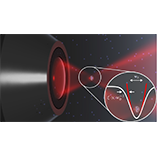November 26, 2013
In a recent study, researchers of the Plasmon nano-optics group led by ICREA Prof. at ICFO Romain Quidant in collaboration with Prof. Lukas Novotny at ETH, achieved the highest force sensitivity ever observed with a nano-mechanical resonator. The scientific results of this study have been published in Nature Physics.
Despite recent advances in the design and fabrication of mechanical resonators, their Q-factor has so far been limited by coupling to the environment through physical contact to a support. To overcome this limitation, the present work has proposed to use optically levitated objects in vacuum that do not suffer from clamping losses.
ICFO researchers have optically levitated nanoparticles in high vacuum conditions and measured the highest Q-factor ever observed in nano- or micromechanical systems. The combination of an ultra-high Q-factor with the tiny mass of the nanoparticles leads to an unprecedented force sensitivity at room temperature. The system is so sensitive that the weak forces arising from collisions between the nanoparticle and the residual air molecules are enough to drive it into the nonlinear regime. This study demonstrates for the first time that ultra-high Q-factor nano-resonators intrinsically behave nonlinearly.
The advent of this new class of nano-mechanical oscillators will open new avenues for ultrasensitive force sensing and benefit the experimental investigation of quantum physics.
Link to paper
Plasmon Nano-optics group led by Prof. Romain Quidan

Ultra-sensitive force sensing
Thermal nonlinearities in a nanomechanical oscillator in Nature Physics.

A silica nanoparticle trapped by tightly focused laser beams













